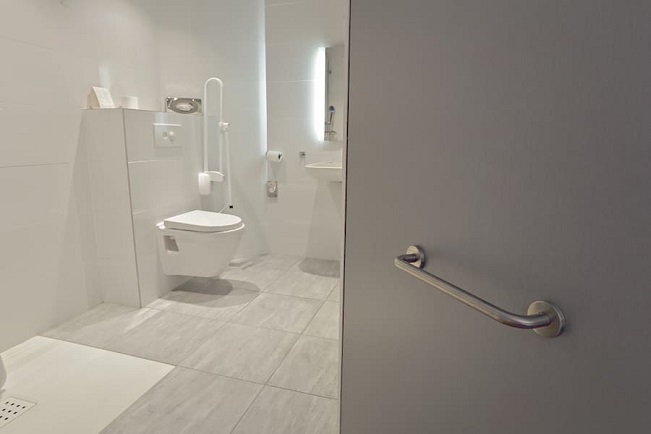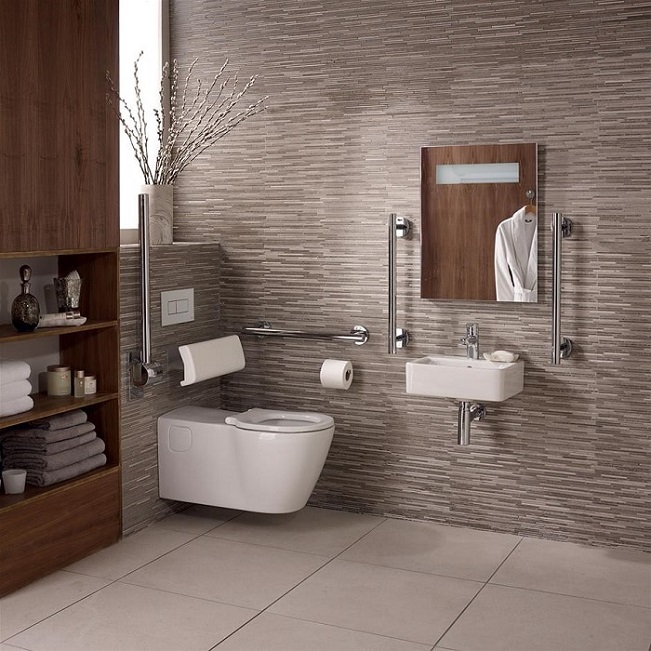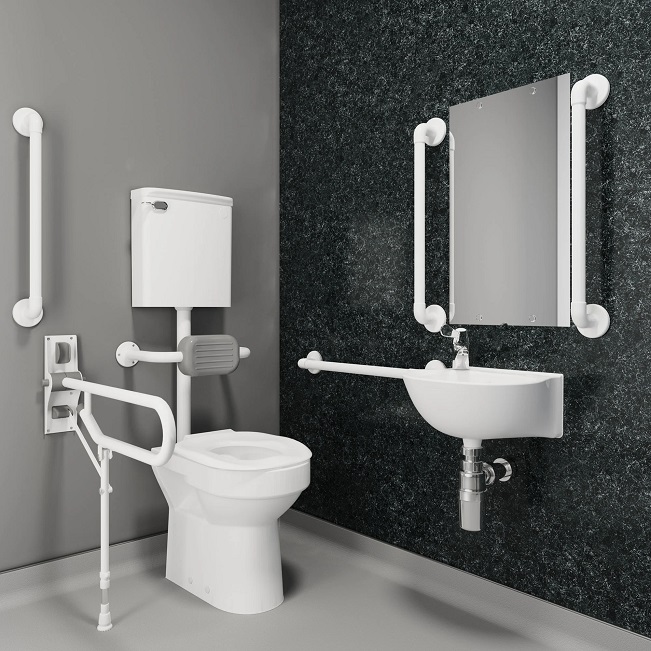An accessible bathroom goes beyond mere functionality; it’s a haven of comfort, independence, and inclusivity for people with disabilities. It’s important to understand the key elements that make a bathroom suitable for disabled individuals. Whether you’re an architect, a homeowner, or simply an advocate for inclusivity, read on and discover some ingenious solutions that will help you to create a bathroom that extends a warm welcome to everyone.
From their spaciousness to their specialised features, stylish and functional disabled toilets are game-changers for anyone who requires extra support and accessibility in the bathroom. They’re taller than standard toilets, so individuals with mobility challenges can easily sit down and stand up without straining or discomfort. What’s more, their design often includes features like flush buttons at a lower height, making them accessible for people with limited reach.
Appropriate Toilet Height

It may sound like a small detail, but the right toilet seat height can make a world of difference in terms of comfort and independence. It’s like finding that sweet spot where comfort and functionality come together. For starters, let’s talk about seats that are too low.
Imagine having to go through the struggle of lowering yourself down to a low toilet seat. This is especially challenging for individuals with limited mobility or strength. It can strain muscles, cause discomfort, and make the whole process a lot harder than it needs to be.
On the flip side, accessible toilets that are too high can also present difficulties. Imagine trying to sit down on a tall toilet seat and feeling like your feet are dangling in mid-air. It’s not exactly the most stable or comfortable position, is it?
So, what height should disabled toilets be? Well, an accessible bathroom should have a toilet that strikes the perfect balance—a height that’s just right for the individual using it. It’s all about finding that Goldilocks zone, where the height is neither too low nor too high, but just perfect.
Generally, a height of around 43 cm is considered suitable for most people. However, it’s always best to consult with a healthcare professional or an accessibility expert who can provide recommendations based on the individual’s abilities and needs.
Comfortable Seat
Comfort plays a significant role in ensuring a positive and inclusive experience for those with diverse needs. Look for disabled toilets in Australia that are wide enough to provide ample space for the person to sit comfortably. Some individuals require a larger seat to accommodate their body shape or mobility device. Additionally, considering a seat with a contoured shape will offer extra support and comfort.
The material of the seat is worth considering too. Soft and cushioned seats provide additional comfort, especially for individuals who spend more time on the toilet due to their disability. These seats reduce pressure points and provide a more pleasant experience.
Spacious Layout

Having enough space allows for better manoeuvrability within the bathroom. It’s essential to ensure that there is ample room for a person with a disability to navigate their mobility aids, such as wheelchairs, walkers, or crutches. Wide pathways and clearances are necessary for easy movement from one area to another.
It’s also crucial to have enough space around the disabled toilet, sink, and shower/bathtub. This allows for proper positioning and transfer for individuals who need assistance or have limited mobility. For example, having space on both sides of the toilet allows for easier transfers from a wheelchair or mobility aid.
Non-Slip Surfaces
Non-slip surfaces ensure safety and prevent accidents, particularly for people with disabilities who have difficulties with balance or mobility. They prevent slips, trips, and falls. It’s essential to consider the flooring material and ensure that it provides adequate traction, even when it’s wet.
Smooth and slippery surfaces, such as polished tiles or glossy flooring, can be hazardous, especially in areas prone to moisture, like near the shower or bathtub. So, opt for a slip-resistant flooring material with a texture that will reduce the risk of accidents.
One option is to choose tiles with a rougher texture or a matte finish, as they tend to offer better grip. Another possibility is using non-slip vinyl or rubber flooring, which provides excellent traction, even when it’s wet. These materials are often more slip-resistant and can be a safer choice for an accessible bathroom.
Grab Rails

Grab rails, also known as grab bars, are sturdy handrails that you can strategically install in various areas of the bathroom to assist disabled individuals with balance, stability, and movement. They offer a reliable means of support, especially for tasks such as transferring to and from the disabled toilet, getting in and out of the shower or bathtub, and navigating around the bathroom.
One of the primary benefits of grab rails is that they promote safety and help prevent falls. They provide a firm grip and support, reducing the risk of slips or accidents in areas where individuals may be vulnerable due to wet surfaces or limited mobility. By having grab rails within reach, your friend or family member will feel more confident and secure while manoeuvring in the bathroom.
It’s important to install grab rails at appropriate heights and in convenient locations. The height and positioning should consider the specific needs and abilities of the individual using the bathroom. For example, grab rails near the toilet should be at a height that allows for comfortable support when sitting down or standing up. In the shower or bathtub area, you should install grab rails in places that help with balance and stability during bathing.
Emergency Call System
An emergency call system serves as a crucial safety feature, providing individuals with disabilities or mobility challenges with a means to call for help in case of an emergency, a fall, or any other situation requiring immediate help. This is particularly vital in bathrooms, where accidents or incidents can occur that can hinder a person’s ability to reach out for aid independently.
The call system typically includes an accessible button or pull cord. It’s important to position the device in a convenient and reachable location, considering the height and mobility of the intended users. Ideally, it should be within easy reach from both the toilet and the bathtub area.
























